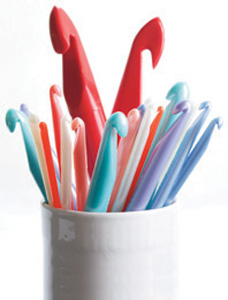This column by Barbara Breiter, author of The Complete Idiot’s Guide to Knitting & Crocheting, originally appeared in The Weekly Stitch newsletter.
 Knitting needles and crochet hooks are as varied as the crafters who utilize them. There is no right or wrong when you select a one. Needles and hooks have specific attributes based on the material they are made from and the manufacturers specifications. Only you can decide what type of needle or hook you like best and you may find that, depending upon the yarn you are using, you’ll reach for a different type than you used for your last project.
Knitting needles and crochet hooks are as varied as the crafters who utilize them. There is no right or wrong when you select a one. Needles and hooks have specific attributes based on the material they are made from and the manufacturers specifications. Only you can decide what type of needle or hook you like best and you may find that, depending upon the yarn you are using, you’ll reach for a different type than you used for your last project.
If you can afford it, buy several different types so that you can experiment and find your favorite.
Some needles have very blunt tips while others have sharper tips. Some hooks have rounded heads and others have pointier heads. The shank (the smaller part of the needle or hook prior to where the sized portion begins) varies in length. You may never find these factors of much importance, or you may find it’s the difference between a tool that allows you to work swiftly and one that just seems to hang you up.
Tip: If you find your yarn to be “splitty” with a hook or needles that have sharper tips, try tools with more blunt tips.
 These tools are made in a wide variety of materials. You’ll find them available in plastic, aluminum, bamboo, rosewood, ebony, and much more. When selecting the tools for a project, you should consider three factors based on materials: weight, temperature, and how slippery they are.
These tools are made in a wide variety of materials. You’ll find them available in plastic, aluminum, bamboo, rosewood, ebony, and much more. When selecting the tools for a project, you should consider three factors based on materials: weight, temperature, and how slippery they are.
Plastic and bamboo is lighter while aluminum is heavier. This is more of a factor in knitting than crocheting because you have two needles you are using and they are longer than hooks. You might prefer aluminum overall, and if you are knitting something light such as booties, the weight of the needles will probably be of little or no consequence. However, with a larger project, you may choose to use a different set of needles.
Bamboo and wood remain at a fairly constant temperature. They will not feel cold to the touch on a cold winter night. Aluminum conducts heat and cold so they might feel hot if you are knitting in the sun or cold if it’s cool wherever you may be knitting.
Yarns can vary in terms of how “sticky” or “slippery” they are. You may find your slippery yarn sliding right off aluminum needles, which tend to be quite slick. Bamboo, which has more grip, would be a better choice here. On the other hand, if you are knitting with a yarn that tends to stick, you might want to use a more slippery needle. Tip: If your needles or hook is too sticky and you don’t have others to select from, rub some wax paper over it and the yarn will glide much easier.
In addition to the above, circular needles and some Tunisian hooks (also called Afghan hooks) may pose yet another factor to consider. The joins, where the needles or hook meet the cable, are different depending upon the brand. Some may catch the yarn while others are much smoother. Some swivel, making the tool more flexible.
Tip: To straighten the cables, put them in hot water for a minute. The kinks will come out of the cable.
Editor’s Note: If you’re finding that you’re having trouble achieving the gauge in a pattern and you’re between hook or needle sizes, try a hook/needles made of a different material, as the “stickiness” or “slipperiness” may affect how tightly or loosely you knit or crochet. Remember, an accurate gauge is the key to getting an accurately sized garment!
–-
To sign up for the Weekly Stitch and get columns like this, free patterns, how-to videos and more, click here.